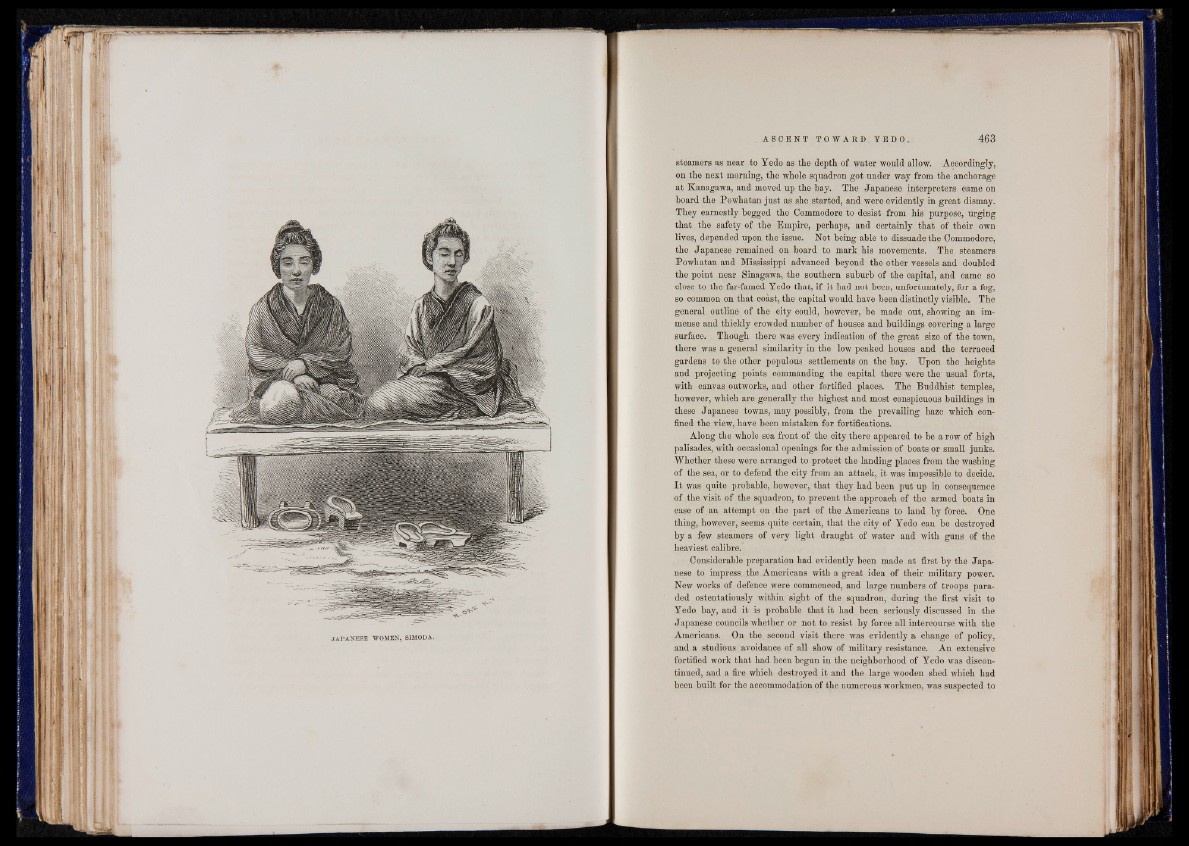
stoamers as near to Yedo as the depth of water would allow. Accordingly,
on the next morning, the whole squadron got under way from the anchorage
at Kanagawa, and moved up the hay. The Japanese interpreters came on
board the Powhatan just as she started, and were evidently in great dismay.
They earnestly begged the Commodore to desist from his purpose, urging
that the safety of the Empire, perhaps, and certainly that of their own
lives, depended upon the issue. Not being able to dissuade the Commodore,
the Japanese remained on board to mark his movements. The steamers
Powhatan and Mississippi advanced beyond the other vessels and doubled
the point near Sinagawa, the southern suburb of the capital, and came so
close to the far-famed Yedo that, if it had not been, unfortunately, for a fog,
so common on that coast, the capital would have been distinctly visible. The
general outline of the city could, however, be made out, showing an immense
and thickly crowded number of houses and buildings covering a large
surface. Though there was every indication of the great size of the town,
there was a general similarity in the low peaked houses and the terraced
gardens to the other populous settlements on the hay. Upon the heights
and projecting points commanding the capital there were the usual forts,
with canvas outworks, and other fortified places. The Buddhist temples,
however, which are generally the highest and most conspicuous buildings in
these Japanese towns, may possibly, from the prevailing haze which confined
the view, have been mistaken for fortifications.
Along the whole sea front of the city there appeared to be a row of high
paliBades, with occasional openings for the admission of boats or small junks.
Whether these were arranged to protect the landing places from the washing
of the sea, or to defend the city from an attack, it was impossible to decide.
I t was quite probable, however, that they had been put up in consequence
of the visit of the squadron, to prevent the approach of the armed boats in
case of an attempt on the part of the Americans to land by force. One
thing, however, seems quite certain, that the city of Yedo can be destroyed
by a few steamers of very light draught of water and with guns of the
heaviest calibre.
Considerable preparation had evidently been made at first by the Japanese
to impress the Americans with a great idea of their military power.
New works of defence were commenced, and large numbers of troops paraded
ostentatiously within sight of the squadron, during the first visit to
Yedo bay, and it is probable that it had been seriously discussed in the
Japanese councils whether or not to resist by force all intercourse with the
Americans. On the second visit there was evidently a change of policy,
and a studious avoidance of all show of military resistance. An extensive
fortified work that had been begun in the neighborhood of Yedo was discontinued,
and a fire which destroyed it and the large wooden shed which had
been built for the accommodation of the numerous workmen, was suspected to